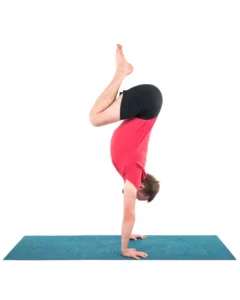Can Frog Pose (Mandukasana) Really Help with Digestion and Relieve Constipation?
A Close-Up of the Anatomy of Mandukasana

Article At A Glance
Frog Pose (Mandukasana) is a deep hip opener that can also affect the digestive organs. Here’s how yoga can benefit us (plus how to practice it!).
If you’ve ever experienced digestive issues, you know how uncomfortable and frustrating they can be. Luckily, yoga offers a wide range of poses that can help alleviate these issues, including Frog Pose (or Mandukasana in Sanskrit). In this article, we’ll take a closer look at this pose and how it can help with digestion and relieve constipation.
Let’s start with the meaning of the name, Mandukasana. Manduka is a Sanskrit word that means frog, and asana means pose. This pose is called Frog Pose because it resembles the posture of a frog.
The Anatomy of Frog Pose in Yoga
 Now, let’s dive into the anatomy of the pose. Frog Pose is a deep hip opener that stretches the inner thighs, groin, and hips. It also engages the pelvic floor muscles and mula bandha, or the root lock.
Now, let’s dive into the anatomy of the pose. Frog Pose is a deep hip opener that stretches the inner thighs, groin, and hips. It also engages the pelvic floor muscles and mula bandha, or the root lock.
The muscles being stretched in this pose include the adductors, which are the muscles responsible for bringing the legs toward the midline of the body, and the hip flexors, which are the muscles that lift the legs toward the torso. These muscles can become tight and shortened due to long periods of sitting or standing, leading to discomfort and pain.
 Frog Pose also strengthens the muscles of the pelvic floor, which are responsible for supporting the bladder, uterus, and rectum. These muscles can become weak due to pregnancy, childbirth, or aging, leading to urinary incontinence and other issues.
Frog Pose also strengthens the muscles of the pelvic floor, which are responsible for supporting the bladder, uterus, and rectum. These muscles can become weak due to pregnancy, childbirth, or aging, leading to urinary incontinence and other issues.
When practiced effectively, Frog Pose can put pressure on the digestive organs, including the stomach, intestines, and colon, which can help tone the digestive tract. This can lead to improved digestion and relief from constipation.
Here’s How to Practice Frog Pose
 To practice Mandukasana in the Iyengar style, follow these instructions:
To practice Mandukasana in the Iyengar style, follow these instructions:
- Start on your hands and knees in a tabletop position.
- Bring your knees wider than hip-width apart, with your toes pointing outward. You may wish to add additional padding under your knees by doubling up your mat or placing a blanket or towel under you.
- Keep your hands and feet in line with your knees.
- Press your hands and feet firmly into the ground.
- Inhale and lengthen your spine.
- Exhale and lower your hips toward the ground, keeping your spine long.
- Relax your head and neck, and breathe deeply. You may wish to lower the weight of your torso onto a prop(s) like a bolster or stack of pillows.
- Hold the pose for 30 seconds to 1 minute, or as long as comfortable.
- To come out of the pose, inhale and lift your hips back up to the starting position.
As with any yoga pose, it’s important to listen to your body and only go as far as comfortable. If you experience any pain or discomfort, come out of the pose immediately.
The Takeaway on Frog Pose

In conclusion, Frog Pose or Mandukasana is a powerful pose that can help with digestion, relieve constipation, and strengthen the pelvic floor muscles.
By stretching the inner thighs, groin, and hips and engaging the muscles of the pelvic floor, this pose can improve overall health and well-being.
So, next time you’re experiencing digestive issues, try Frog Pose and see how it can benefit you.
Also, read...
4 Ways to Practice Locust Pose
5 Keys to Healthy Neck Alignment in Cobra Pose (Bhujangasana)
Uttanasana: Expand Your Breath
Related courses
Breath as Medicine: Yogic Breathing for Vital Aging
Yoga and Myofascial Release: Releasing Chronic Tension with the Bodymind Ballwork Method

Leah Sugerman is a yoga teacher, writer, and passionate world traveler. An eternally grateful student, she has trained in countless schools and traditions of the practice. She teaches a fusion of the styles she has studied with a strong emphasis on breath, alignment, and anatomical integrity. Leah teaches workshops, retreats, and trainings, both internationally and online. For more information, visit www.leahsugerman.com.



